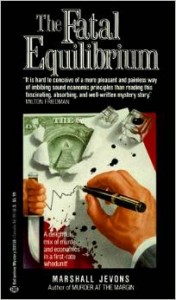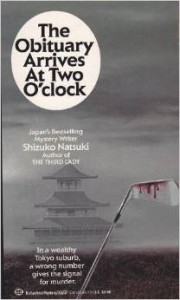Fatal Equilibrium by Marshall Jevons (Ballentine Books 1985)
 I reviewed Marshall Jevons’ (pseudonym for two economists’) first book, Murder at the Margin, a couple years ago. I sent for the sequel, Fatal Equilibrium, but was sorely disappointed.
I reviewed Marshall Jevons’ (pseudonym for two economists’) first book, Murder at the Margin, a couple years ago. I sent for the sequel, Fatal Equilibrium, but was sorely disappointed.
Fatal Equilibrium has a few moments of levity, but overall it lacks the delightful explorations of economic theory in response to a murder when Professor Henry Spearman and his wife are vacationing on a remote Caribbean island resort.
On the contrary, Fatal Equilibrium is didactic, cerebral, and as bloodless as the murder of its main character, Dennis Gossen, a quite unlikeable tenure candidate in the Economics Department at Harvard University.
Unfortunately, if you’re a fan of Harvard or Cambridge, Massachusetts you won’t see either place in this book—the only memorable setting for Henry Spearman’s economic thoughts is at the clothing sales melee in the basement of Filene’s Department Store.
Most of the action in this book, what little of it there is, takes place in Harvard faculty homes, yards, or apartments, and in the meeting room where Harvard’s multi-disciplinary committee holds its discussions about Gossen’s qualifications.
The structure of this mystery is really poor. There’s no suspenseful buildup—it opens with the depiction of Gossen’s murder at the hands of someone he knows. Then the plot flips back in time to the beginning of the tenure committee’s evaluation of Gossen. Each of the ensuing chapters is named only with a date.
Fatal Equilibrium‘s chronological order makes it more like reading a detective’s murder book notes than a mystery book.
As a result, the characters of the committee faculty, along with Dean Clegg who oversees the tenure committee, are the main sources of amusement in this book, and they offer the only clues the reader gets to try to solve the murder.
Over an issue similar to today’s carbon credits, Professor Morrison-Bell, a dedicated bird-lover and the first victim to die, detests the candidate’s article on allowing air polluters to bid on licenses to pollute. That sounds to him like James Bond’s “license to kill”.
Valerie Gossen, the psychologist who has had sexual relations with the candidate for tenure and decides to hide that fact, dislikes the candidate’s simplistic belief in “economic man” a concept categorizing all men as rational and utilitarian beings. That flies in the face of what modern psychologists know, she thinks.
The sociologist, Oliver Wu, who lost out to Clegg for the Dean’s job, is offended by the candidate’s article suggesting that higher salaries should be offered in markets where it is more difficult to monitor purchasing agents’ activities. The high salary is to keep the “rational employee” from taking bribes (or cheating their employer in other ways).
Sofie Ustinov, the chemistry professor from the Soviet Union, doesn’t like the candidate’s paper about finding an “optimal number of brands.” Although she buys the “most expensive caviar-type” dog food for her pet, she believes that only one brand for all other commodities is quite sufficient.
Foster Barrett, the blue-blood member from one of Boston’s first families who fancies himself a chef, feels tenure should be reserved only for those with “refined tastes”. That most certainly isn’t Dennis Gossen.
It becomes clear even to Dennis that he hasn’t a chance at being tenured. Being an “economic man, ” Dennis perhaps has resorted to blackmail to obtain tenure. Is that why he was murdered?
It only remains for Henry Spearman to work out which member of the committee wanted Morrison Bell, Foster Barrett, as well as Dennis Gossen dead. And of course, using economics, Henry does figure out whodunnit.
My advice is, read this book for the characters and their antics on the Harvard tenure committee. Skim over Henry’s speeches about economic concepts. They are not connected by the authors to the mystery itself. Only when you know whodunnit will these mini-lectures, in particular the one at Filene’s, make any sense in the context of the murder.
There also seems to be a gigantic hole in the plot created by the fact that, despite his reputation as a solver of murders, there is no suggestion of Henry Spearman’s life being in jeopardy at any point in the story line—even though he is a member of Dennis Gossen’s tenure committee too.
The Obituary Arrives at Two O’clock by Shizuko Natsuki (Ballentine Books 1988)
 The arc or impetus for this mystery starts with the acute stagflation that has slowly strangled the Japanese economic system for decades. Not surprising is the fact that the resulting financial shenanigans in this murder mystery story take place at two upscale golf courses in Japan.
The arc or impetus for this mystery starts with the acute stagflation that has slowly strangled the Japanese economic system for decades. Not surprising is the fact that the resulting financial shenanigans in this murder mystery story take place at two upscale golf courses in Japan.
In January 2012, a Financial Times story concerned the Taiheiyo Club, one-time owner of Pebble Beach Resorts in the US, and 18 golf courses in Japan. Taiheiyo filed for bankruptcy, the third biggest bankruptcy in Japan at that time. FT comments that other leisure businesses, such as pinball parlors, fitness clubs, and theme parks in Japan were also suffering from Japan’s economic woes.
This book is by the popular and prolific writer, Shizuko Natsuke. Her main character, Kosuki Okita, is a the landscaping contractor for the Ichihara and Tanzawa Country Clubs owned by two deadbeat partners, Mr Nasuno and Mr. Kawai. Shortly after Okita has an argument about the money the two men owe him, Nasuno’s body is found in a ditch in front of his home.
This book, unlike Fatal Equilibrium is quite suspenseful as Okita becomes a fugitive and tries to figure out who committed the murder the police think he was guilty of, and it has a fun love story to boot. Rather than introducing students to a few concepts from economics, The Obituary gives a macroeconomic picture of corruption and crime when a financial boom turns into an economic crisis for a whole country.
For a more recent Japanese bestseller that “affords us a view of a Japan where money is tight and where there are social problems,” see The Devotion of Suspect X by Keigo Higashino (Little, Brown, 2011), reviewed in the Financial Times in 2011.
1 comment so far ↓
Murder mysteries, involving economics, high profile characters, intellects and wealthy people, what an interesting combination!! Thanks for sending.
Leave a Comment